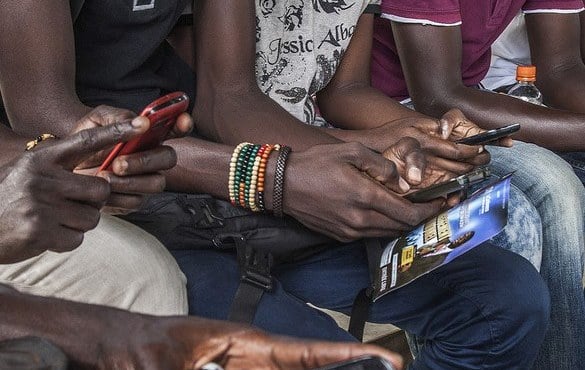How many minutes of mobile video do Americans consume every day? What is happening to the market for mobile accessories? Where do Chinese people buy their smartphones?
You’ll find the answers to these and many more mobile data related questions in this week’s MEF market stats round up…

Americans used 9.6 trillion megabytes of mobile data in 2015
Soaring demand for mobile video has tripled the consumption of mobile data in the US over three years.
New stats from the CTIA reveal that Americans used 9.6 trillion megabytes of mobile data in 2015, compared with 3.2 trillion MB in 2013. This is the equivalent of consumers streaming 59,219 videos every minute.
The report says there are 228 million active smartphones in the US, and that 70 per cent of the population now owns one. There were more than 41 million tablets on wireless networks, up 16 per cent from 2014.
Other highlights include:
- Americans talked more than 2.8 trillion minutes on their phones, up more than 17 per cent from 2014
Americans exchanged more than 2.1 trillion texts, videos and photo messages
America’s wireless carriers invested almost $32 billion in 2015 to improve coverage and capacity
Read more…
Sales of aftermarket mobile accessories will top $110 billion in 2021
The market for Bluetooth headsets, screen protectors, protective cases and chargers is set to grow nine per cent a year.
The boom will deliver a market worth $110 billion in five years’ time, says a new report from ABI Research.
People have always wanted to personalise their devices, which sustains the market for accessories. But new tech is helping too. For example, features like anti-glare, anti-fingerprint, anti-scratch, and higher transmittance are driving demand for screen protectors.
Industry changes affect it too. Rumours suggest Apple is about to remove the headphone jack from new devices, for example. If so, users will have to buy additional headsets and adapters for their smartphones.
Read more…
Half of Chinese smartphone owners buy their devices online
China’s phone market have moved from the high street to the web, says a new report by ABI Research.
It says more than 50 per cent of respondents in China report purchasing a mobile phone online, compared to 356 per cent of US consumers.
The study cites two main reasons for the online preference. One is that the market is largely prepaid, which means that Chinese consumers cannot derive many benefits from buying in-store via MNOs.
The second factor is the relative lack of physical stores. Apple, for instance, has 32 stores in China, compared to the 268 stores it currently operates in the US.
It’s why local brands in particular – Huawei and Xiaomi – sell so many devices online and via chat apps like WeChat.
Read more…
85 per cent of Facebook video is watched with the sound off
Facebook is believed to be hosting eight billion views per day on its video platform, but most viewers are watching in silence.
A report on Digiday says multiple publishers have confirmed the phenomenon. LittleThings, for instance, which is averaging 150 million monthly views on Facebook says 85 per cent of views take place without the sound on. Millennial news site Mic said the same.
It’s not too surprising. Facebook is mostly a mobile channel with viewers tuning in when volume is not necessarily an option. Video makers are working around this – making films with visuals or titles that don’t necessitate sound.
“Sound is still an option [on Facebook], but it’s not required,” said Rye Clifton, director of experience at ad agency GSD&M. “If you can make something compelling without needing people to turn the audio on, you’re ahead of people who are not thinking that way.”
Read more…
Seven in ten Americans have used a sharing economy service
Services like Lyft, Uber and AirBnB have entered the mainstream in the US, say new statistics from Pew Research Center.
Its survey of 4,787 American adults – the first-ever on the impact of the collaborative economy – found that 72 per cent of American adults have used at least one of 11 services. Around one-in-five have used four or more of these services, and seven per cent have used six or more.
A small number of citizens remain ignorant of the idea. The study found that 28 per cent of Americans have not used any major shared platforms, and many are wholly unfamiliar with them. For instance, 30 per cent have never heard of ride-hailing apps like Uber or Lyft.
Read more…
Over 40s don’t really trust any company to protect their privacy
The extent of the distrust surrounding digital brands have been revealed in a new study by Optimal.
It found that 63.9 per cent of 45 to 59 year old Americans and 62.4 per cent of over 60s ‘don’t trust any entity to protect my personal information.” Suspicion was less among Millennials, with 37.3 per cent answering in the same way.
Trust in organisations varies across the market. Facebook and Google score the worst. Just 4.5 per cent of over 60s trust Facebook. Meanwhile banks fare best across all ages ranges. 71 per cent of 18 to 29 year olds trust banks.
The study by Optimal.com and Wells Fargo Securities also examined attitudes to ad blocking and paying for content.
Read more…
Sign up now to MEF’s Mobile Messaging Programme – The Future of Messaging. A cross-ecosystem approach to accelerate market clean-up and advance innovation. Find out more and download the free A2P messaging fraud framework now











